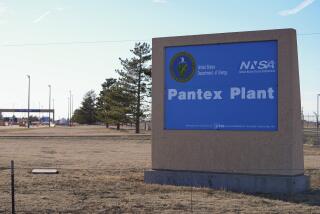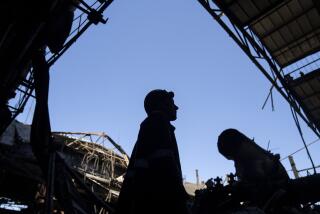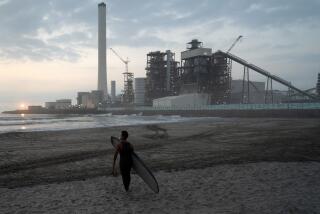Radioactive Release Is Over but Fire Rages, They Believe : Non-Nuclear Blast Probably Touched Off Crisis, Scientists Say
The Soviet power plant accident involved a non-nuclear explosion, probably caused by a loss of reactor coolant, and released most of the radiation within the first few hours, according to experts in the United States who are familiar with the Chernobyl facility.
Thus, even though the plant continues to burn so fiercely that workers apparently cannot get close enough to try to put out the fire, additional radioactive materials are not likely to escape in significant quantities.
Although there were reports in Washington that the situation has stabilized, experts said Tuesday that the fire could continue for days. And because of intense radiation, it would be impossible to get into the immediate area; therefore, the Soviets may have no recourse except to allow the fire to burn itself out.
Blocks of Graphite
The fire is in blocks of graphite, a coal-type substance which encases the uranium fuel in the reactor’s core. The graphite slows the speed of neutrons emitted by the fuel, thus making them more susceptible to the fission process.
“We suspect they had a loss-of-coolant accident,” said a top official with G A Technologies, a San Diego company that built the only commercial reactor in this country that is somewhat similar to the Chernobyl plant.
After the loss of coolant, temperatures in the reactor would soar, and the first line of defense would be to pump cooling water into the reactor core. But experts suspect that the Soviet reactor was so hot that the emergency cooling water probably flashed to steam as soon as it hit the core, creating pressures too great for the reactor vessel to contain.
“That explosion probably opened up the graphite to air, and at high temperatures in the presence of air, it will burn,” said the G A Technologies official, who asked that he not be identified by name.
Damage to Fuel Pellets
He said graphite is “just like coal, but it is very dense” and that under those circumstances, it would burn at very high temperatures.
The heat would seriously damage the uranium fuel pellets, thus venting radioactive byproducts of the fission process into the air. The Soviet plant did not have the kind of containment dome that houses nuclear plants in the United States.
This scenario holds that the greatest damage would have been done within hours of the accident and that workers in the immediate area would have probably been killed by the explosion; others undoubtedly would have been exposed to heavy dosages of radiation--possibly to fatal levels.
One scientist who visited the Soviet plant in 1977, a year before it was finished, said he is convinced that a loss of coolant to some area of the reactor precipitated the accident.
‘Doesn’t Take Much Heat’
“It doesn’t take much heat in one area” to warp the channels through which cooling water is supposed to flow, said Edward Siegel, who was with the International Atomic Energy Agency in Vienna when he visited the plant.
He said loss of coolant is “the only way a local area could get hot enough” to damage the reactor. If that happened, it might be impossible to insert the rods into the reactor that would shut it down, and cooling water might be blocked from reaching other areas, thus allowing the problem to expand, Siegel said.
But Julius Goodman, a former Soviet physicist who now works at California State University, Long Beach, said he does not consider a loss-of-coolant accident likely because the Chernobyl reactor was cooled by hundreds of individual cooling loops. U.S. reactors, in contrast, use one primary cooling loop and various backup systems.
‘Human Error, Malfunction’
“I think it was some kind of combination of human error and unexpected technical malfunction which led to damage (of the reactor’s core),” said Goodman.
He noted that Soviet reactors are designed so that workers can refuel part of the reactor while it is still running, simply by replacing part of the graphite core which houses the uranium. U.S. reactors must be shut down during refueling operations.
The graphite must also be “cleaned” of radioactive contamination from time to time, and that is done by allowing the reactor to heat up beyond its normal operating temperatures.
D. Allan Bromley, professor of physics at Yale University, described that operation as a “very ticklish, precarious business” because if the reactor gets too hot, the stainless steel container around the graphite bricks could melt, exposing the hot graphite to air. If that happened, it would burst into flames, Bromley said in Washington at a meeting of the American Physical Society.
Basically, most power plants are similar, regardless of the type of fuel they burn.
The heart of the system is the “fire box,” the part of the plant that produces heat. Non-nuclear plants burn coal, oil, gas or even wood to produce heat. In nuclear plants, the “fire box” is a nuclear reactor.
Heat is used to convert water to steam to turn the giant turbines that generate electricity.
In a nuclear plant, radioactive byproducts must be contained.
To sustain the nuclear reaction, a “moderator” must be used to slow neutrons emitted during the fissioning process. In most reactors in the United States, water is used for that purpose. The Soviet reactor used graphite.
To keep temperatures within operating limits, all reactors must be cooled constantly. Like most reactors in the United States, the Chernobyl plant used water for that purpose.
Times staff writer Rudy Abramson in Washington also contributed to this story.
More to Read
Sign up for Essential California
The most important California stories and recommendations in your inbox every morning.
You may occasionally receive promotional content from the Los Angeles Times.










